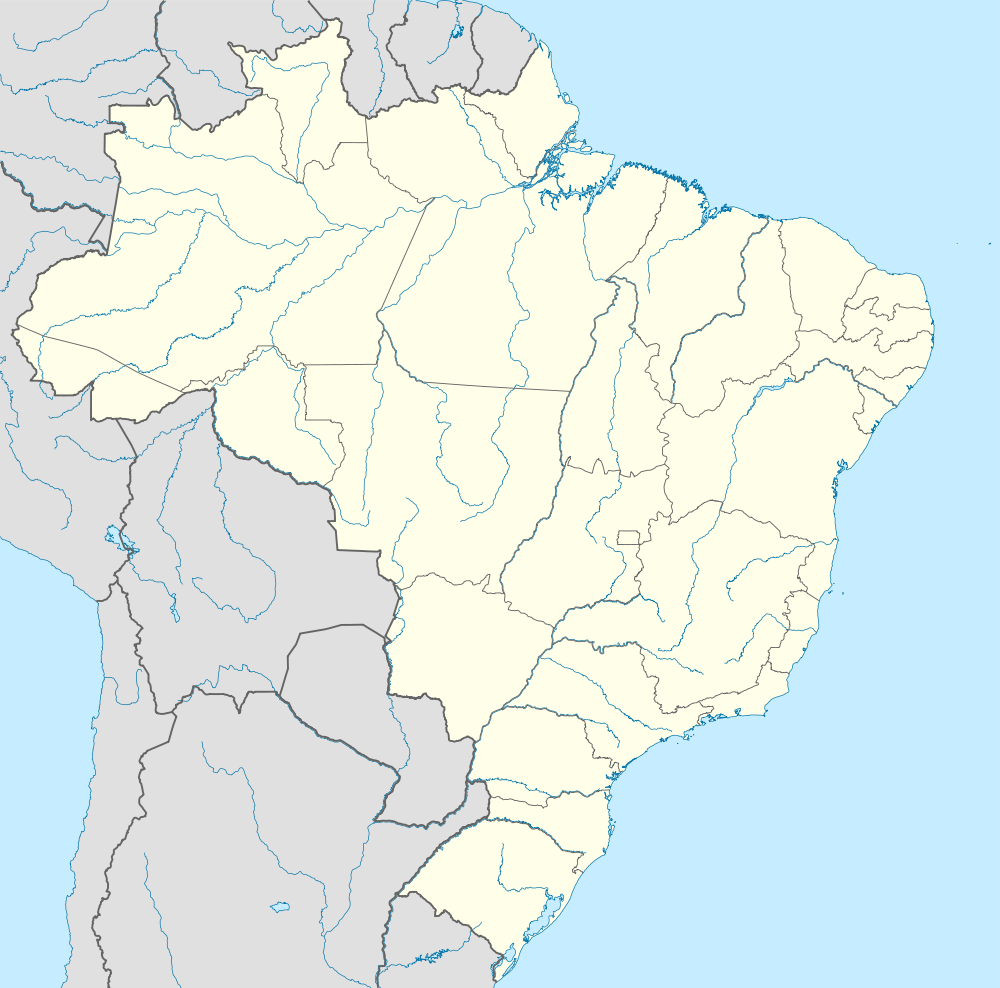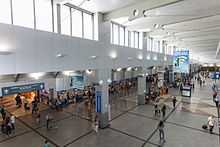Deputado Luís Eduardo Magalhães International Airport
| Salvador-Deputado Luís Eduardo Magalhães International Airport (2 de Julho) Aeroporto Internacional de Salvador-Deputado Luís Eduardo Magalhães (2 de Julho) | |||||||||||||||
|---|---|---|---|---|---|---|---|---|---|---|---|---|---|---|---|
 | |||||||||||||||
| IATA: SSA – ICAO: SBSV | |||||||||||||||
| Summary | |||||||||||||||
| Airport type | Public/Military | ||||||||||||||
| Operator | Infraero | ||||||||||||||
| Serves | Salvador da Bahia | ||||||||||||||
| Elevation AMSL | 20 m / 64 ft | ||||||||||||||
| Coordinates | 12°54′31″S 038°19′21″W / 12.90861°S 38.32250°WCoordinates: 12°54′31″S 038°19′21″W / 12.90861°S 38.32250°W | ||||||||||||||
| Website | Infraero SSA | ||||||||||||||
| Map | |||||||||||||||
 SSA Location in Brazil | |||||||||||||||
| Runways | |||||||||||||||
| |||||||||||||||
| Statistics (2013) | |||||||||||||||
| |||||||||||||||
Salvador-Deputado Luís Eduardo Magalhães International Airport (IATA: SSA, ICAO: SBSV), formerly called Dois de Julho International Airport is the airport serving Salvador da Bahia, Brazil. Since 16 June 1998 the airport is named after Luís Eduardo Maron Magalhães (1955–1998), an influential politician of the state of Bahia.[4]
It is operated by Infraero.
Some of its facilities are shared with the Salvador Air Force Base of the Brazilian Air Force.
History
The airport, originally called Santo Amaro do Ipitanga Airport, was founded in 1925. In 1941 Panair do Brasil participating in the World War II efforts with the support of the American and Brazilian governments completely rebuilt the facility.
On 20 December 1955, the airport had its name changed for the first time: it became known as Dois de Julho International Airport, celebrating Bahia Independence Day. This is still the name by which the population of Salvador da Bahia call the facility. On 16 June 1998 the airport name was again changed to its present form, honoring Luís Eduardo Maron Magalhães (1955–1998) an influential politician of the state of Bahia. This second change remains however controversial and there have been attempts to revert it.[5]
The airport is located in an area of more than 6 million square meters between sand dunes and native vegetation. The lush, bamboo-covered road to the airport has become one of the scenic attractions of Salvador da Bahia.
A brand new passenger terminal was opened in 1998, replacing the original outdated terminal. This new terminal continued to be upgraded and was completed by the end of year 2000. The main terminal, which includes a shopping mall has 69,400 m², 11 jetways and a capacity to handle 6,000,000 passengers/year. Traffic has been growing at an average of 14% per year.
Airlines and destinations


Passenger
Cargo
| Airlines | Destinations |
|---|---|
| Total Linhas Aéreas | Belo Horizonte-Confins, Fortaleza, São Paulo-Guarulhos |
Accidents and incidents
Accidents with fatalities

- 21 September 1944: a Panair do Brasil Lockheed Model 18 Lodestar registration PP-PBH crashed shortly after take-off from Salvador da Bahia. All 18 occupants died.[7][8]
- 31 May 1950: an Aerovias Brasil Douglas C-47-DL registration PP-AVZ, en route from Vitória to Salvador da Bahia disintegrated on air, while flying over Itacaré, near Ilhéus. It was flying under extremely bad conditions and entered a cumulus nimbus. Passengers and cargo were moved aboard and as a consequence control was lost. Both wings separated from the aircraft as it descended at great speed. Of the 13 passengers and crew aboard, 2 survived.[9][10]
- 11 July 1952: a Brazilian Air Force Douglas C-47A-35-DL registration FAB-2048 flying from Salvador da Bahia to Rio de Janeiro crashed following an engine fire. Thirteen of the 33 occupants died.[11]
- 1 March 1959: a Brazilian Air Force Douglas C-47A-85-DL registration FAB-2060 flying from Rio de Janeiro to Salvador da Bahia crashed en route killing all 18 occupants.[12]
- 3 February 1992: a Nordeste Embraer EMB 110 Bandeirante registration PT-TBB operating flight 92 from Salvador da Bahia to Guanambi, descended below minimum levels in bad weather and crashed on a hill hidden by clouds near Caetité. All 12 passengers and crew aboard died.[13][14]
- 17 November 1996: a Brazilian Air Force Embraer P-95 Bandeirante registration FAB-7102 flying from Salvador da Bahia to Natal Air Force Base had an accident in the vicinity of Caruaru. Four Brazilian Air Force Bandeirantes were flying on formation from Salvador da Bahia to Natal when the tail of FAB-7102 was struck by the propeller of another aircraft. Control of the aircraft was lost and it crashed. All 9 occupants died.[15]
Incidents
- 15 May 1973: a VASP Vickers Viscount registration PP-SRD was damaged beyond economic repair when it departed the runway on landing and the undercarriage collapsed.[16]
Access
The airport is located 28 km (17 mi) north from downtown Salvador da Bahia.
Future developments
On 31 August 2009 Infraero unveiled an ambitious BRL5.3 billion (USD2.8 billion; EUR2.0 billion) investment plan to renovate and upgrade airports of ten cities focusing on the preparations for the 2014 FIFA World Cup which will be held in Brazil. At the occasion it was announced that even though Salvador da Bahia is one of the venue cities, the plan excluded its airport because renovations had been recently completed and Infraero considered the airport fit to handle the forthcoming increases in traffic.[17]
See also
References
![]() This article incorporates public domain material from websites or documents of the Air Force Historical Research Agency.
This article incorporates public domain material from websites or documents of the Air Force Historical Research Agency.
- ↑ "Movimento operacional da rede Infraero de janeiro a dezembro de 2013" (PDF) (in Portuguese). Infraero. 4 February 2014. Retrieved 8 June 2014.
- ↑ "Airport Official Website" (in Portuguese). Infraero.
- ↑ "Lista de aeródromos públicos" (in Portuguese). ANAC.
- ↑ "Lei n˚9.661, de 16 de junho de 1998" (in Portuguese). Lei Direto. 16 June 2009. Retrieved 30 May 2011.
- ↑ "Projeto de lei 6106/2002" (PDF) (in Portuguese). Câmara dos Deputados do Brasil. 21 February 2002. Retrieved 9 June 2011.
- ↑ Gol Salvador starts direct flights to Buenos Aires
- ↑ "Accident description PP-PBH". Aviation Safety Network. Retrieved 9 June 2011.
- ↑ Germano da Silva, Carlos Ari César (2008). "Mais um Lodestar". O rastro da bruxa: história da aviação comercial brasileira no século XX através dos seus acidentes 1928–1996 (in Portuguese) (2 ed.). Porto Alegre: EDIPUCRS. pp. 69–72. ISBN 978-85-7430-760-2.
- ↑ "Accident description PP-AVZ". Aviation Safety Network. Retrieved 13 May 2011.
- ↑ Germano da Silva, Carlos Ari César (2008). "A sobrevivente". O rastro da bruxa: história da aviação comercial brasileira no século XX através dos seus acidentes 1928–1996 (in Portuguese) (2 ed.). Porto Alegre: EDIPUCRS. pp. 91–94. ISBN 978-85-7430-760-2.
- ↑ "Accident description FAB-2048". Aviation Safety Network. Retrieved 8 June 2011.
- ↑ "Accident description FAB-2060". Aviation Safety Network. Retrieved 8 June 2011.
- ↑ "Accident description PT-TBB". Aviation Safety Network. Retrieved 1 May 2011.
- ↑ Germano da Silva, Carlos Ari César (2008). "Nordeste 092". O rastro da bruxa: história da aviação comercial brasileira no século XX através dos seus acidentes 1928–1996 (in Portuguese) (2 ed.). Porto Alegre: EDIPUCRS. pp. 371–375. ISBN 978-85-7430-760-2.
- ↑ "Accident description FAB-7102". Aviation Safety Network. Retrieved 9 May 2011.
- ↑ "Accident description PP-SRD". Aviation Safety Network. Retrieved 8 October 2009.
- ↑ "Infraero vai gastar R$5 bi em reforma de aeroportos". Valor Econômico. 31 August 2009. Retrieved 9 October 2009.
External links
| Wikimedia Commons has media related to Deputado Luís Eduardo Magalhães International Airport. |
- Airport information for SBSV at World Aero Data. Data current as of October 2006.Source: DAFIF.
- Airport information for SBSV at Great Circle Mapper. Source: DAFIF (effective Oct. 2006).
- Current weather for SBSV at NOAA/NWS
- Accident history for SSA at Aviation Safety Network
- Deputado Luís Eduardo Magalhães International Airport Photo Archive at airliners.net
| ||||||||||||||||||
| ||||||||||||||||||||||
| ||||||||||||||||||||||||||||||||||||||